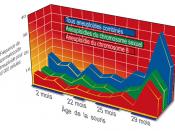Determining Sex:
What determines a child's sex? Usually it is the sex chromosomes in which two X chromosomes in the nucleus of its original egg cell and it will become a female; a Y and an X chromosome and it will become a male. An egg will have at least one female determining X chromosome. A sperm cell, however, may contain either an X chromosome or a Y chromosome. If the fertilizing sperm cell contains an X chromosome, the egg will develop into a female. If it contains a Y chromosome, it will develop into a male. Nonetheless, it is possible for an XY to become female. If the Y chromosome is missing the SRY gene, which is located near the end of the short arm of the chromosome, the egg will develop into a female. At three weeks of fetal development, there is no sign of gonads. By the fifth week, genital ridges have begun to form near the kidneys.
These ridges (gonads) will transform into either ovaries or testes. Until the seventh week, the genital ridge is similar in both males and females. Primitive germ cells, which will later become either sperm or eggs cells, migrate from the embryo's yolk sac to the genital ridge. These germ cells are integrated into the primitive sex chord, which are fingerlike projections that have formed over the previous week.
Male development:
Sex is finally determined the last half of the sixth week. If the Y chromosome is present in the embryo's cells, a gene within the short arm of the chromosome called SRY will turn on, initiating a chemical chain reaction that will turn on other genes and stimulate the production of male hormones. If the X chromosome is present, or if the SRY gene is missing from the Y...


